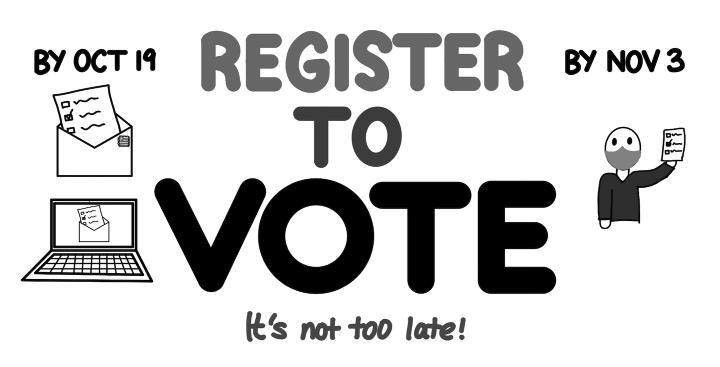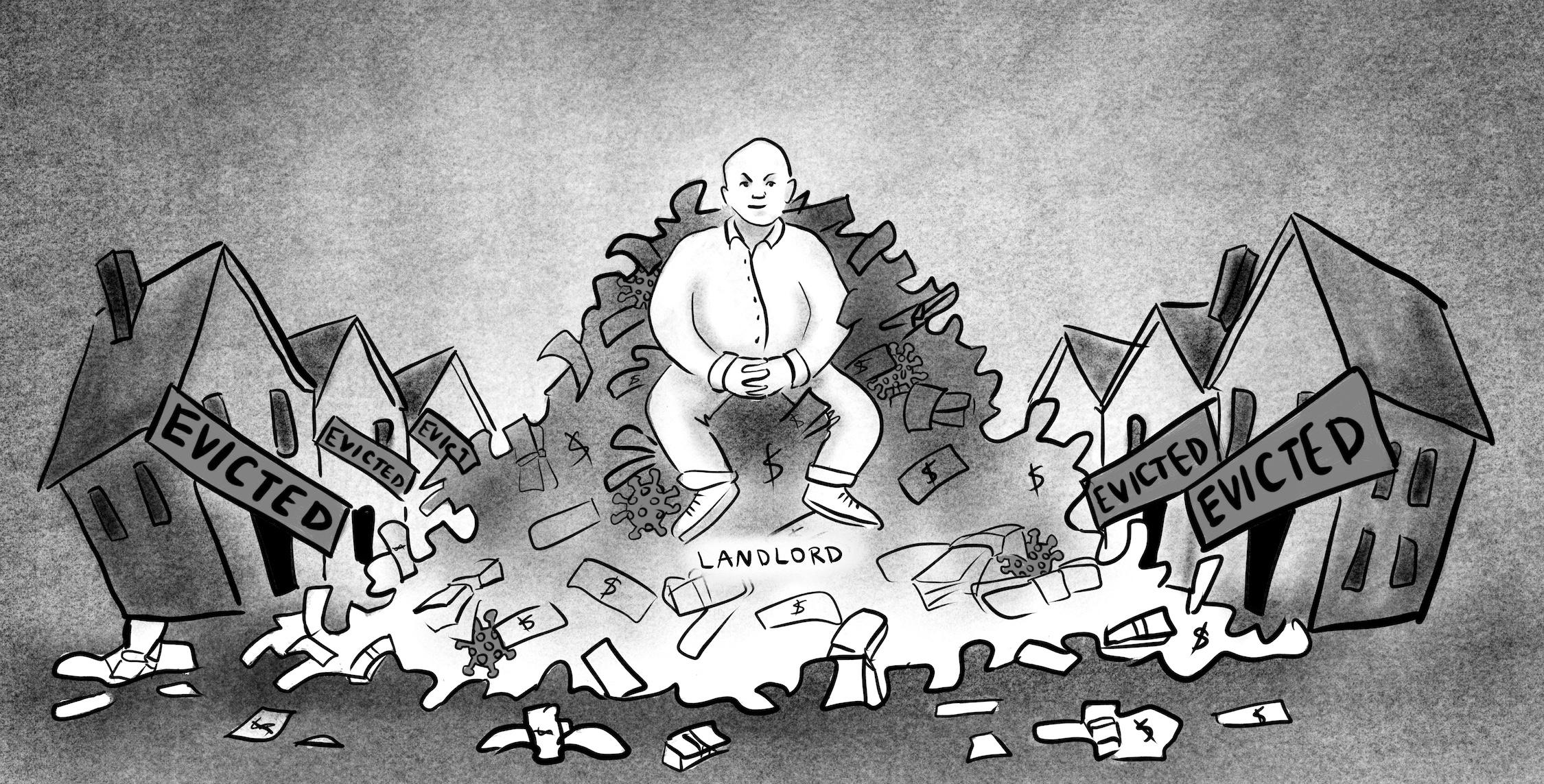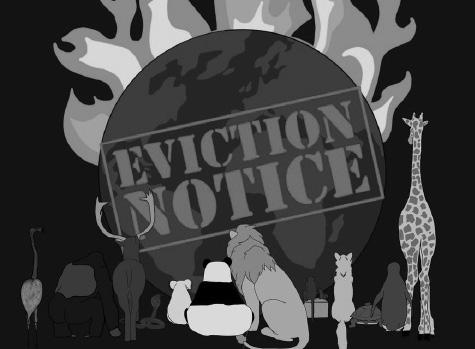14 — Wednesday, October 14, 2020
statement
Ann Arbor: Not immune to the COVID-19 housing crisis O
n the last Friday of August, Craig Teschendorf passed the day wondering where he and his puppy Eleanor would go after his eviction from the Orion MainStreet apartment complex in Ann Arbor. In a touching act of unity and protest, about 20 members from the area showed up to successfully postpone the eviction of the elderly disabled retiree. Photos from the event show a diverse, masked community successfully coming together to protect a vulnerable citizen of their city amid a pandemic. The protest was able to keep Craig off the streets until the end of September, when staff from the apartment complex and Ann Arbor police showed up to carry out the eviction. In an email, the Ann Arbor Tenants Union wrote that he is still looking for housing for him and Eleanor. Though Craig is becoming the face of the anti-eviction movement in the Ann Arbor area, evictions are still taking place across the nation no matter the coronavirus case count or the perils of wildfires, hurricanes and other aggressive weather. While the United States housing crisis did not start with the pandemic — in fact, it has been a decades-long problem — the circumstances of the pandemic have certainly exacerbated this growing issue. The economic toll of the COVID-19 pandemic has left millions both temporarily and permanently unemployed across the U.S. The national unemployment rate skyrocketed to over 14% in the beginning of summer and is currently projected to dip below 8%. Adding to the problem, the number of permanent job losses is increasing, creating a negative outlook on the job market as the U.S. continues to stagger through the economic consequences of the pandemic, left uncontrolled by an administration incapable of acknowledging and addressing the worst public health crisis in over 100 years. Irrespective of the abysmal public health policy of the 45th president, the Trump administration’s culture of downplaying the severity of the virus to the American public and refusal to follow Centers for Disease Control and Prevention guidelines are enough to impose blame for the state of the nation. All of this economic turmoil has resulted in an estimated 30 to 40 million Americans facing the threat of eviction, mounting debt, late fees and interest due to back rent and the legal consequences of unpaid rent, such as a wage garnishment if landlords sue to evict a tenant. In September, an unprecedented, nationwide eviction moratorium was declared by the CDC to protect renters and prevent the spread of COVID-19, but the effectiveness of this action is unknown as evictions continue to take place across the country, even in Ann Arbor, and landlords challenge the legality of the moratorium itself. Needless to say, the housing crisis is not exclusive to Ann Arbor, which is already one of the most economically segregated cities in
The Michigan Daily — michigandaily.com
BY LEAH LESZCZYNSKI, STATEMENT COLUMNIST the Ann Arbor City Council, wrote of the painful truth of the housing crisis during COVID-19. “The pandemic definitely helped make many more people aware of this crisis but it did not cause it,” Disch said. Citing a 2015 study of American metros, Disch continued. “Ann Arbor has never been an inexpensive place to live but it is no exaggeration to say that we are currently facing a housing crisis,” she wrote. “Not only is Ann Arbor the eighth most economically segregated city in the nation — not Michigan but the nation — but ILLUSTRATION BY MAGGIE WIEBE we are second in the nation for excluding ‘essensures, such as cutting rent or allowing renttial workers’ from living alongside the people ers to terminate their leases under once-in-awho depend on them.” century circumstances. Amid the crisis, there The University’s role in the Ann Arbor have been heartwarming stories of landlords housing market is worth noting: “Over the last showing great empathy to renters, but these 15 years, UM enrollment has grown by 8,557 few instances are the exception, not the rule. students, up 22%, while just under 6,000 beds According to an employee at Z West Aparthave been added between new apartments ments who spoke to me on the condition of and dorms in the downtown/campus area.” anonymity, students can break their leases Where does the University expect these adafter paying six monthly installments. Google ditional nearly 2,500 students to live? What Reviews from May 2020 claim that McKindoes the University expect to happen to the ley Properties offered a 5% percent rent cut, cost of housing when students must compete which after its annual rent increase, did not with a growing Ann Arbor population for a seem very meaningful to tenants. In addition, place to live, and they do not guarantee onI talked to a number of landlords who worked campus housing? to waive subleasing or late fees for a period of Disch commented on the recent growth time. of the student population. As described to me by many landlords over “I do think that the growth of enrollment the phone, their policies did not change due and employment at the U (the problem is to the pandemic because their tenants have not just adding more students but adding not had trouble paying rent, and did not exmore jobs generally) have contributed to press the need for rent concessions — so, there the housing crisis but it is important not to seems to be no reason to cut rent. If this is the lose sight of these long-term trends. We’ve case, the income of landlords, based in legallybinding leases, should be relatively stable. Yet been coasting along with an outdated vision several landlords have applied for financial of the city that has accelerated inequities support made possible by the Paycheck Pro- and reduced racial and economic diversity,” she wrote. tection Program. The impacts of redlining and racial disData from the U.S. Small Business Admincrimination are twisted into the economic istration shows many landlords in Ann Arbor, inequality seen throughout the country and in response to the pandemic, received low inbecome even more apparent during these terest, federally backed loans that may be forcrises. The disparities that make home owngiven under certain circumstances. According ership more difficult for Black and Hispanic to a data project from ProPublica, McKinley households compared to white people and Companies received between $5 and 10 mileviction rates that put minorities at a larger lion, Cabrio Capital and Cabrio TNM Holdrisk of ending up on the streets are insepaings received between $150,000 and $350,000 rable from health and wealth inequalities each, Wickfield Properties between $350,000 and $1 million, Wilson White Company be- that are exacerbated by the pandemic. Actween $150,000 and $350,000 and Landmark cording to the CDC, “long-standing sysProperties, the nation’s top developer of stu- temic health and social inequities have put dent housing that has stakes in Z West, Z many people from racial and ethnic minorPlace and Foundry Lofts, received between $5 ity groups at increased risk of getting sick and dying from COVID-19.” Understanding and 10 million. If tenants are not having trouble paying the reciprocal relationships between ownrent, as high-rise complexes and landlords ing or having a stable place to call home, with houses across Ann Arbor told me over maintaining health and building wealth is the phone, why do these enormous compa- key to understanding the disproportionate nies need coronavirus bailout money? Where impact of the pandemic and the housing criexactly is it going? And who exactly is benefit- sis on minority communities.
the nation. Though over half of University of Michigan students come from the top 20% of American households and have differing levels of concern and parental support when it comes to paying rent, many students struggle to cover the cost of housing even without a pandemic and its crippling effects on the economy. While the fact that 78% of undergraduate credits are now offered virtually makes the need for housing in Ann Arbor less pressing, the obligations of student renters have remained intact for the most part. From all over the country and around the world, students flocked back to Ann Arbor in August to fulfill already-signed leases. With the fall semester underway, the issue of housing for the academic year may have faded in the list of students’ most pressing concerns. I spoke to Gayle Rosen, a landlord and tenant attorney for Student Legal Services, to learn more about student housing concerns amid the pandemic. She said that “(SLS) received hundreds of calls in the spring when U-M decided to move to online learning. Students headed home and said they wanted to break their lease because they no longer needed to stay in Ann Arbor in order to complete their schoolwork, or because they lost their jobs and could not afford their apartment. We have also heard from students who needed to return home to help care for a family member as a result of the pandemic.” After the University declared its plans for a “public-health informed” semester, “SLS received a lot of calls from students who wanted to terminate their leases for 2020-2021 because they decided not to come back (to campus),” Rosen said. Rosen acknowledged that for students, the problem is that there is not a strong legal basis to terminate their leases, even during a pandemic. Because leases do not often contain provisions that allow for an early termination due to an emergency, rent is still due and leases are still binding for many students, no matter how dire the circumstances. Needless to say, the housing crisis is just another straw on the camel’s back for many students juggling the typical stressors of college life that have intensified during the pandemic. To all the Ann Arbor landlords I spoke ting? to over the phone, the public health and economic crises are not enough to convince them that desperate times call for desperate mea-
I
n an email, Lisa Disch, a professor in the Department of Political Science and Women’s Studies, and member of
Read more at MichiganDaily.com ILLUSTRATIONS BY EILEEN KELLY





